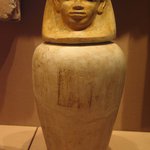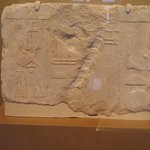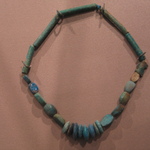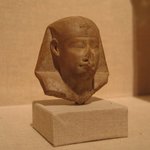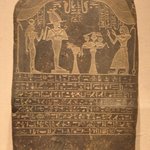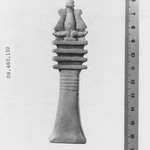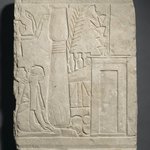
Offering Bearers
Egyptian, Classical, Ancient Near Eastern Art
On View: 19th Dynasty to Roman Period, Martha A. and Robert S. Rubin Gallery, 3rd Floor
Among the most common motifs found in Egyptian tombs is the formal presentation of offerings. The complete scene to which this fragment belonged showed a row of men bringing gifts to an offering table laden with bread, meat, fowl and metal vessels probably containing wine. Of particular interest is the brace of ducks or geese suspended from a hand at the far right. The style of the faces and the elaborate design of the costumes owe much to the inspiration of the Amarna Period. The composition of the scene, however, is far more formal than similar designs executed during the reign of Akhenaten.
MEDIUM
Limestone, pigment
DATES
ca. 1323–1250 B.C.E.
DYNASTY
late Dynasty 18 to early Dynasty 19
PERIOD
New Kingdom
DIMENSIONS
15 7/8 x 19 1/8 in. (40.3 x 48.5 cm) (show scale)



COLLECTIONS
Egyptian, Classical, Ancient Near Eastern Art
ACCESSION NUMBER
37.1505E
CREDIT LINE
Charles Edwin Wilbour Fund
CATALOGUE DESCRIPTION
Limestone tomb relief. At right, procession of funerary priests (two complete figures and portion of a third) bearing offerings. Priests have shaved heads and wear long, pleated skirts. At left, large mass of funerary offerings. Minute portions of lower portion of upper register preserved.
Condition: Poor. Lower left portion lost as are adjoining portions of surface. Stone slightly salty. Remains of red paint on heads and bodies of priests. Lower portion was never worked; left edge had lost worked surface from salt action.
EXHIBITIONS
MUSEUM LOCATION
This item is on view on the 19th Dynasty to Roman Period, Martha A. and Robert S. Rubin Gallery, 3rd Floor
CAPTION
Offering Bearers, ca. 1323–1250 B.C.E. Limestone, pigment, 15 7/8 x 19 1/8 in. (40.3 x 48.5 cm). Brooklyn Museum, Charles Edwin Wilbour Fund, 37.1505E. Creative Commons-BY (Photo: Brooklyn Museum, CUR.37.1505E_wwg8.jpg)
IMAGE
installation, West Wing gallery 8 installation, CUR.37.1505E_wwg8.jpg. Brooklyn Museum photograph, 2006
"CUR" at the beginning of an image file name means that the image was created by a curatorial staff member. These study images may be digital point-and-shoot photographs, when we don\'t yet have high-quality studio photography, or they may be scans of older negatives, slides, or photographic prints, providing historical documentation of the object.
RIGHTS STATEMENT
Creative Commons-BY
You may download and use Brooklyn Museum images of this three-dimensional work in accordance with a Creative Commons license. Fair use, as understood under the United States Copyright Act, may also apply.
Please include caption information from this page and credit the Brooklyn Museum. If you need a high resolution file, please fill out our online application form (charges apply).
For further information about copyright, we recommend resources at the United States Library of Congress, Cornell University, Copyright and Cultural Institutions: Guidelines for U.S. Libraries, Archives, and Museums, and Copyright Watch.
For more information about the Museum's rights project, including how rights types are assigned, please see our blog posts on copyright.
If you have any information regarding this work and rights to it, please contact copyright@brooklynmuseum.org.
RECORD COMPLETENESS
Not every record you will find here is complete. More information is available for some works than for others, and some entries have been updated more recently. Records are frequently reviewed and revised, and we welcome any additional information you might have.












